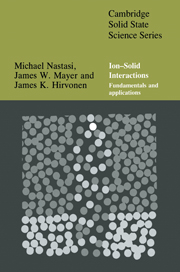Book contents
- Frontmatter
- Contents
- List of symbols
- Preface
- Chapter 1 General features and fundamental concepts
- Chapter 2 Interatomic potentials
- Chapter 3 Dynamics of binary elastic collisions
- Chapter 4 Cross-section
- Chapter 5 Ion stopping
- Chapter 6 Ion range and range distribution
- Chapter 7 Radiation damage and spikes
- Chapter 8 Ion–solid simulations and diffusion
- Chapter 9 Sputtering
- Chapter 10 Order–disorder and ion implantation metallurgy
- Chapter 11 Ion beam mixing
- Chapter 12 Phase transformations
- Chapter 13 Ion beam assisted deposition
- Chapter 14 Applications of ion beam processing techniques
- Chapter 15 Ion beam system features
- Appendix A Crystallography
- Appendix B Table of the elements
- Appendix C Density of states
- Appendix D Derivation of the Thomas–Fermi differential equation
- Appendix E Center-of-mass and laboratory scattering angles
- Appendix F Miedema's semi-empirical model for the enthalpy of formation in the liquid and solid states
- Appendix G Implantation metallurgy – study of equilibrium alloys
- Appendix H Physical constants, conversions and useful combinations
- Index
Chapter 12 - Phase transformations
Published online by Cambridge University Press: 27 January 2010
- Frontmatter
- Contents
- List of symbols
- Preface
- Chapter 1 General features and fundamental concepts
- Chapter 2 Interatomic potentials
- Chapter 3 Dynamics of binary elastic collisions
- Chapter 4 Cross-section
- Chapter 5 Ion stopping
- Chapter 6 Ion range and range distribution
- Chapter 7 Radiation damage and spikes
- Chapter 8 Ion–solid simulations and diffusion
- Chapter 9 Sputtering
- Chapter 10 Order–disorder and ion implantation metallurgy
- Chapter 11 Ion beam mixing
- Chapter 12 Phase transformations
- Chapter 13 Ion beam assisted deposition
- Chapter 14 Applications of ion beam processing techniques
- Chapter 15 Ion beam system features
- Appendix A Crystallography
- Appendix B Table of the elements
- Appendix C Density of states
- Appendix D Derivation of the Thomas–Fermi differential equation
- Appendix E Center-of-mass and laboratory scattering angles
- Appendix F Miedema's semi-empirical model for the enthalpy of formation in the liquid and solid states
- Appendix G Implantation metallurgy – study of equilibrium alloys
- Appendix H Physical constants, conversions and useful combinations
- Index
Summary
Introduction
Ion irradiation of crystalline metallic alloys causes structural changes. Crystalline phase can become amorphous or can change to a different crystalline structure. The transformation can be to metastable or equilibrium phases. The driving force for an irradiation induced transformation is provided by the energy to the lattice during the penetration and subsequent stopping of an energetic ion (see Chapter 7).
To understand irradiation induced phase transformations on a thermodynamic level, let us consider an A–B binary phase diagram and the associated free energy of three of the components (Fig. 12.1). We choose A and B to be fcc metals, AB3 to be a line compound with many atoms per unit cell, AB to be a simple CsCl structure with an extended phase field (the CsCl structure has two atoms per unit cell) that exists over a 10 to 20% range in composition, and the region α to be an fcc solid solution. A free energy curve with small curvature (wide phase field) indicates that the irradiation induced deviations from equilibrium do not result in large increases in the compound's free energy. Large curvature (narrow phase field) indicates just the opposite; small increases in the equilibrium defect concentration or changes in composition produce large increases in the free energy. As a result, compounds with large phase fields can tolerate a higher degree of irradiation damage and should be more irradiation stable relative to compounds with narrow phase fields (Brimhall et al., 1983; Hung et al., 1983).
- Type
- Chapter
- Information
- Ion-Solid InteractionsFundamentals and Applications, pp. 332 - 362Publisher: Cambridge University PressPrint publication year: 1996
- 1
- Cited by



